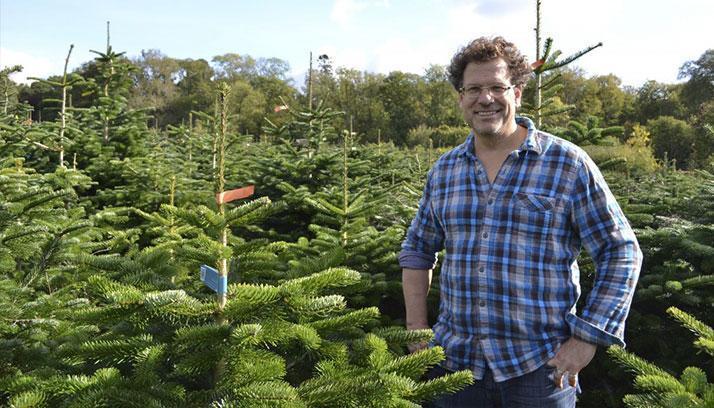SUSTAINABILITY
Many Christmas tree retailers claim their Christmas trees are ‘sustainable’ and eco-friendly. Here Kelty Caston attempts to demystify the subject by answering some key questions about real Christmas trees grown on Christmas tree farms, and the environmental issues that surround them

Does having a real Christmas tree save the planet?
No: In a world of finite resources it will never help save the planet to have a real Christmas tree, a plastic Christmas tree, an electric car or even an organic Brussels sprout (indeed Christmas itself is tough for the environment). Make no mistake consumption is always bad for the planet although as producers frequently remind us, not for the economy or human wellbeing.
Are The Christmas Forest’s Christmas trees sustainable?
Yes. Christmas Forest is an eco-friendly producer, Every tree cut down is replaced with another. They are a crop with a nine year long harvest cycle.
Are Christmas trees grown naturally?
No: Christmas tree farm growers have found that, in common with farmers everywhere, it is very hard to produce an acceptable and economic crop without using modern techniques.
If you are asking “are your Christmas trees eco friendly”, then we make the following comparisons with other crops:
- A nine year harvest cycle means a stable habitat in which other species, especially birds, can flourish.
- A robust slow growing crop of Christmas trees responds better to non-chemical intervention eg pruning, symbiotic plantings, mechanical weeding and will generally require less chemical treatment than more vulnerable cereals and other annuals
- There are fewer chemicals approved and available for use on Christmas trees than for the larger agricultural interests, therefore Christmas tree farms tend to seek alternative means, e.g. mechanical or manual weeding, symbiotic species (ladybirds, clover) rather than the latest chemical fix. However, all our trees are sprayed for pests and chemically fertilised while growing, but there’s no pest spraying within 3 months of harvest.
- Christmas Tree fields are green for longer (ten years between clearances) and runoff (the process of water washing fertilisers and other chemicals into the water supply) is minimal.
- The crop is not for eating and can therefore be grown on “recycled” land (eg landfill, brownfield).
I see, so are the articles I’ve read saying it would be better for the environment if we all bought artificial trees instead of real ones right? Should we all be investing in them instead?
Yes – possibly and with dedication. If you buy an artificial tree and use it for ten years and only then replace it responsibly (they are composite and hard to recycle) you will have created a carbon deficit approximately equal to having a fresh real tree each year and recycling it in the normal way. So if you use an artificial tree for eleven years you will have a greener option.
Of course, all bets are off if you replace your artificial tree before the nine years are up or, for that matter, if you walk or use public transport to get the real tree or better still, buy a potted Christmas tree and plant it out.
So, tell me how much damage am I causing the environment by buying a real Christmas tree?
That is hard to quantify exactly, but very minor in comparison to other common consumption.
Really? So even though I’m creating demand for you to cut down a Christmas tree, this isn’t causing untold damage to the world?
No. Trees consume carbon dioxide and produce oxygen in significant quantities – if it wasn’t for the transportation they would be highly carbon positive.
What about the animals that depend on real Christmas trees? Are their habitats destroyed by my wanton desire for a merry Christmas?
A Christmas tree field habitat is, relative to other agriculture, very stable, diverse, sheltering and non-toxic. It is particularly welcoming to birds. The fieldwould probably have another less benign use if Christmas trees were not grown there.
And transportation? Surely once you add on the cost of all of that, it can’t weigh up ….
Transportation is where the carbon cost does add up. The Christmas Forest tries hard to reduce carbon consumption by sourcing Christmas trees from Christmas tree farms the UK where possible and by operating our sites in residential areas so that our customers can get to us on foot. As with all your travel you can do your bit by walking or using public transport.
And what about getting rid of the Christmas tree afterwards? Is there an eco friendly way of doing that?
Absolutely – the tree should be recycled (chipped) and not end up in landfill. Your local council will have made arrangements for this – see our Collection page for details. As local councils do this in bulk, it’s by far the greenest way to dispose of your tree.
The Christmas Forest would like to remind you that:
- Artificial Christmas trees are manufactured far, far away. They use scarce raw materials and cheap labour.
- Real Christmas trees are british grown in the UK (and Europe). They provide support for British Christmas tree growers.
- A real Christmas tree encourages an appreciation of the natural environment and of folk tradition by bringing both into the home at Christmas time.
- Christmas is a time for giving: the Christmas Forest’s annual contribution to Tree Aid (made with thanks to our customers) is a carefully targeted gift of around 16,000 trees annually to the most needy people in the planet, as well as an effective offset to the environmental burden of our operation.
- Christmas is better and more magical with a real tree – many of us cannot really imagine it without one – try one and see.
Ref:-
- https://www.telegraph.co.uk/christmas/0/real-vs-fake-great-christmas-tree-debate-eco-friendly-tree/ – from the Daily Telegraph citing the Governments Carbon Trust report.
- https://www.christmastreeassociation.org/christmas-tree-fact-guide/ - from the American Artificial Christmas Tree Society


